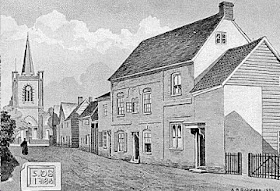In 1707, the River Thames had broken through the protective sea defences in south Dagenham and flooded the marshland beyond.
After many failed attempts, the defences were finally repaired by Captain John Perry in 1719. However, a large lake was left in the landscape, which became known as Dagenham Breach.
The Breach became a popular fishing area and the earliest Ministerial Whitebait Dinners were held there. Elizabeth Fry and her family leased two holiday cottages at the Breach in the early 19th century. Dagenham Breach is now a much smaller lake within the Ford's Motor Works area.
After a number of failed attempts, in 1865 Sir John Rennie ...
... built a jetty and a branch railway, but the company failed financially. Rennie went on to built the massive breakwater at Plymouth and associated naval buildings. The Thames-side site was acquired, and Dagenham Dock was constructed over 30 acres, from 1887 by Samuel Williams.
Despite the developments, Dagenham itself remained a small and insignificant village on the Southend Road, here sketched in 1895.
Almost all of the old village has been "re-developed" over the years, but the church remains, less its little spire.
The dock area was later the site of a large coaling port and continues to be the location of a small terminal licensed to handle coal off-loading. Today the site is used for a number of river-related uses including a 25 acre depot with around 200 tanks for storage of petrol, distillates, aviation fuel, biofuels, tallow and ethanol.
Ford Dagenham was a major car factory which re-located to Dagenham in 1931 ...
... and has produced 10,980,368 cars and over 37,000,000 engines in its history. The factory's power station (bottom right) was adorned by the Europe's largest one-word neon advertising sign.
... built a jetty and a branch railway, but the company failed financially. Rennie went on to built the massive breakwater at Plymouth and associated naval buildings. The Thames-side site was acquired, and Dagenham Dock was constructed over 30 acres, from 1887 by Samuel Williams.
Despite the developments, Dagenham itself remained a small and insignificant village on the Southend Road, here sketched in 1895.
Almost all of the old village has been "re-developed" over the years, but the church remains, less its little spire.
The dock area was later the site of a large coaling port and continues to be the location of a small terminal licensed to handle coal off-loading. Today the site is used for a number of river-related uses including a 25 acre depot with around 200 tanks for storage of petrol, distillates, aviation fuel, biofuels, tallow and ethanol.
Ford Dagenham was a major car factory which re-located to Dagenham in 1931 ...
... and has produced 10,980,368 cars and over 37,000,000 engines in its history. The factory's power station (bottom right) was adorned by the Europe's largest one-word neon advertising sign.
Vehicle assembly ceased at the plant in 2002 but it continues as a major production site with the capacity to assemble 1.4 million engines a year. In 2008 the plant produced around 1,050,000 engines and was the largest producer of Ford diesel engines globally. Employment at the plant peaked at around 40,000 workers in 1953, and the plant currently employs around 4,000 people. The plant covers around 475 acres and has received over £800 million of capital investment since the year 2000.
The London Tilbury and Southend Railway opened its original route to Grays in 1854, extending to Southend in 1856. A station to serve the growing industrial and residential area was opened at Dagenham Dock in 1908. A more direct route via Upminster was developed between 1885 and 1888 leaving Dagenham Dock on what became known as the "Tilbury Loop". Chequers Lane linked the growing town of Dagenham with the station and the dock itself. This 1930s map extract illustrates.
The Chequers Inn at the "town" end of the lane (seen here in 1929)
was demolished in 1987 and replaced with a far less attractive Homebase store; shame.
Episode 2 will delve into the railway's history and present operation.
was demolished in 1987 and replaced with a far less attractive Homebase store; shame.
Episode 2 will delve into the railway's history and present operation.
The river's tent is broken: the last fingers of leaf
Clutch and sink into the wet bank. The wind
Crosses the brown land, unheard. The nymphs are departed.
Sweet Thames, run softly, till I end my song.
Clutch and sink into the wet bank. The wind
Crosses the brown land, unheard. The nymphs are departed.
Sweet Thames, run softly, till I end my song.
From "The Waste Land", T. S. Eliot.
Next blog : due Tuesday August 9th
Dagenham Dock Week
Next blog : due Tuesday August 9th
Dagenham Dock Week












No comments:
Post a Comment